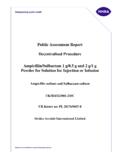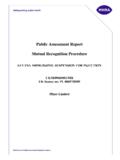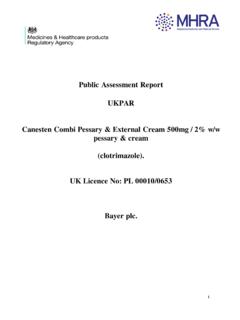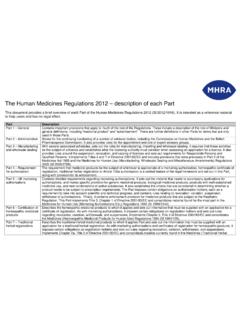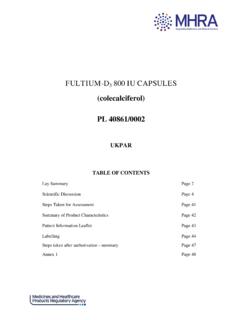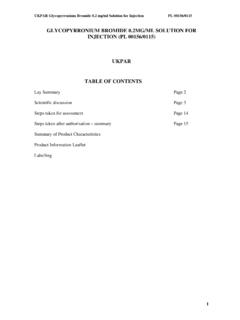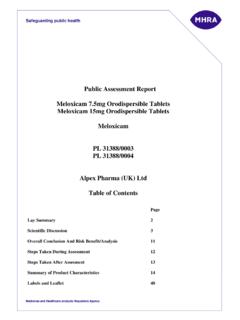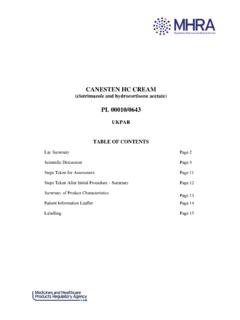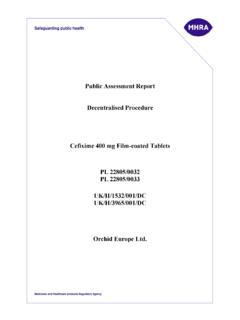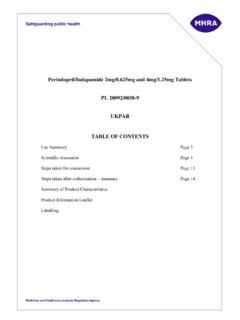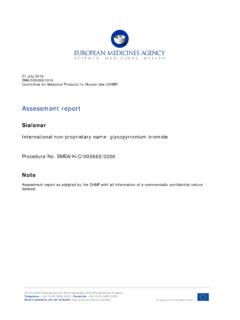Transcription of Public Assessment Report Decentralised Procedure …
1 Public Assessment Report Decentralised Procedure LIOTHYRONINE SODIUM 20 MICROGRAM TABLETS (liothyronine sodium) Procedure No: UK/H/6516/001/DC UK Licence No: PL 00289/2116 Teva UK Limited PAR Liothyronine Sodium 20 microgram Tablets UK/H/6516/001/DC 2 LAY SUMMARY Liothyronine Sodium 20 microgram Tablets (liothyronine sodium) This is a summary of the Public Assessment Report (PAR) for Liothyronine Sodium 20 microgram Tablets (PL 00289/2116; UK/H/6516/001/DC). It explains how Liothyronine Sodium 20 microgram Tablets were assessed and their authorisation recommended as well as their conditions of use.
2 It is not intended to provide practical advice on how to use Liothyronine Sodium 20 microgram Tablets. For practical information about using Liothyronine Sodium 20 microgram Tablets, patients should read the package leaflet or contact their doctor or pharmacist. This medicinal product will be referred to as Liothyronine Sodium Tablets for the remainder of this summary, for ease of reading. What are Liothyronine Sodium Tablets and what are they used for? Liothyronine Sodium Tablets are a generic medicine . This means that Liothyronine Sodium Tablets are similar to a reference medicine already authorised in the European Union (EU) called Liothyronine Sodium BP 20 micrograms Tablets (also known as Tertroxin 20 microgram Tablets).
3 Liothyronine Sodium Tablets are used to treat some of the more severe conditions in which the thyroid does not produce enough thyroxine. They are also used to balance the effect of medicines used to treat an overactive thyroid. How do Liothyronine Sodium Tablets work? Liothyronine Sodium Tablets contain the active ingredient liothyronine sodium, which is a form of thyroxine which is quick acting and long lasting. Thyroxine is a hormone produced by the thyroid gland in the neck which controls many body functions. How are Liothyronine Sodium Tablets taken? This medicine is only available on prescription. Liothyronine Sodium Tablets are taken by mouth.
4 For a dose of 20 micrograms, the tablet should be swallowed whole with a glass of water. For doses lower than 20 micrograms, the tablet should be crushed and allowed to disperse in 20 ml of water for 5 minutes, in a small measuring cup. The patient should stir the suspension gently for 15 seconds and then, using a syringe, they should draw the amount of liquid corresponding to the dose recommended (5 ml for a 5 microgram dose; 10 ml for a 10 microgram dose). The patient can squirt the liquid directly into their mouth from the syringe by gently pressing the plunger. The patient should ask for an appropriate syringe and dosing cup from their pharmacist.
5 The recommended dose in adults will depend upon the condition, ranging from 10 micrograms to 60 micrograms daily in divided doses. For children and the elderly, the dose may be started at 5 micrograms a day. A doctor will monitor the patient s thyroid function regularly to make sure that they are given the right dose for their condition. PAR Liothyronine Sodium 20 microgram Tablets UK/H/6516/001/DC 3 What benefits of Liothyronine Sodium Tablets have been shown in studies? As Liothyronine Sodium Tablets are a generic medicine, studies in people have been limited to tests to determine that it is bioequivalent to the reference medicine, Liothyronine Sodium BP 20 micrograms Tablets (also known as Tertroxin 20 microgram Tablets).
6 Two medicines are bioequivalent when they produce the same levels of the active substance in the body. What are the possible side effects of Liothyronine Sodium Tablets? As Liothyronine Sodium Tablets are a generic medicine, their possible side effects are taken as being the same as those of the reference medicine, Liothyronine Sodium BP 20 micrograms Tablets (also known as Tertroxin 20 microgram Tablets). For the full list of all side effects reported with Liothyronine Sodium Tablets, see section 4 of the package leaflet. For the full list of restrictions, see the package leaflet. Why were Liothyronine Sodium Tablets approved?
7 It was concluded that, in accordance with EU requirements, Liothyronine Sodium Tablets have been shown to have comparable quality and to be bioequivalent to Liothyronine Sodium BP 20 micrograms Tablets. Therefore, the MHRA decided that, as for Liothyronine Sodium BP 20 micrograms Tablets (also known as Tertroxin 20 microgram Tablets), the benefits outweigh the identified risks and recommended that Liothyronine Sodium Tablets could be approved for use. What measures are being taken to ensure the safe and effective use of Liothyronine Sodium Tablets? A risk management plan (RMP) has been developed to ensure that Liothyronine Sodium Tablets are used as safely as possible.
8 Based on this plan, safety information has been included in the Summary of Product Characteristics (SmPC) and the package leaflet for this product including the appropriate precautions to be followed by healthcare professionals and patients. Known side effects are continuously monitored. Furthermore, new safety signals reported by patients/healthcare professionals will be monitored and reviewed continuously. Other information about Liothyronine Sodium Tablets A Marketing Authorisation was granted in the UK on 14 August 2017. The full PAR for Liothyronine Sodium Tablets follows this summary. For more information about treatment with Liothyronine Sodium Tablets, read the package leaflet, or contact your doctor or pharmacist.
9 This summary was last updated in August 2017. PAR Liothyronine Sodium 20 microgram Tablets UK/H/6516/001/DC 4 SCIENTIFIC DISCUSSION TABLE OF CONTENTS I Introduction Page 5 II Quality aspects Page 6 III Non-clinical aspects Page 10 IV Clinical aspects Page 10 V User consultation Page 13 VI Overall conclusion, benefit-risk Assessment and recommendation Page 13 Annex 1 Table of content of the PAR update Page 14 PAR Liothyronine Sodium 20 microgram Tablets UK/H/6516/001/DC 5 I INTRODUCTION Based on the review of the data on quality, safety and efficacy, the Medicines and Healthcare products Regulatory Agency (MHRA)
10 Considered that the application for Liothyronine Sodium 20 microgram Tablets (PL 00289/2116; UK/H/6516/001/DC) could be approved. The application was submitted via the Decentralised Procedure , with the UK as Reference Member State (RMS), and Luxembourg as a Concerned Member State (CMS). Prior to Day 106 of the Procedure , the applicant withdrew Luxembourg from the Procedure . This product is a prescription only medicine (legal classification POM). This application was submitted according to Article 10(1) of Directive 2001/83/EC, as amended, claiming to be a generic medicinal product of the reference product Liothyronine Sodium BP 20 micrograms Tablets (PL 10972/0033; also known as Tertroxin 20 microgram Tablets), which was granted a licence to Mercury Pharma Group Limited, on 23 August 1993.
